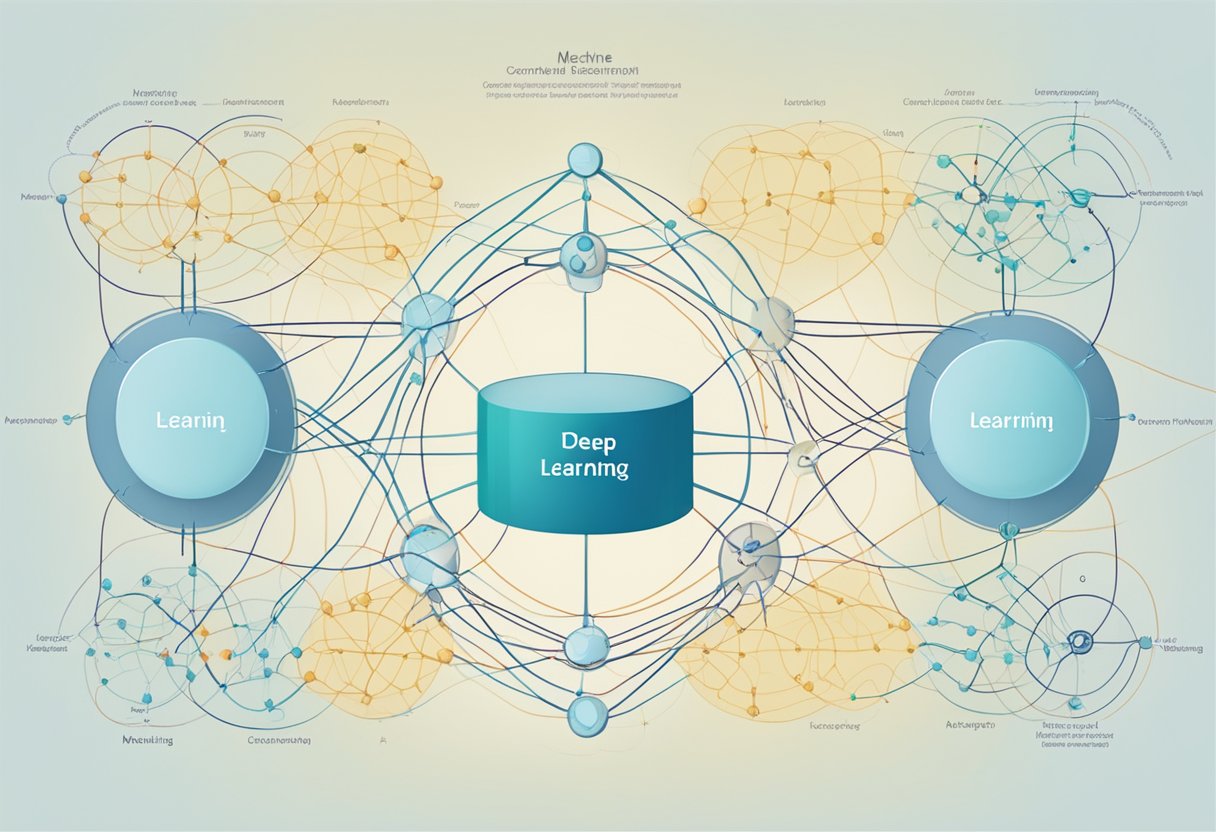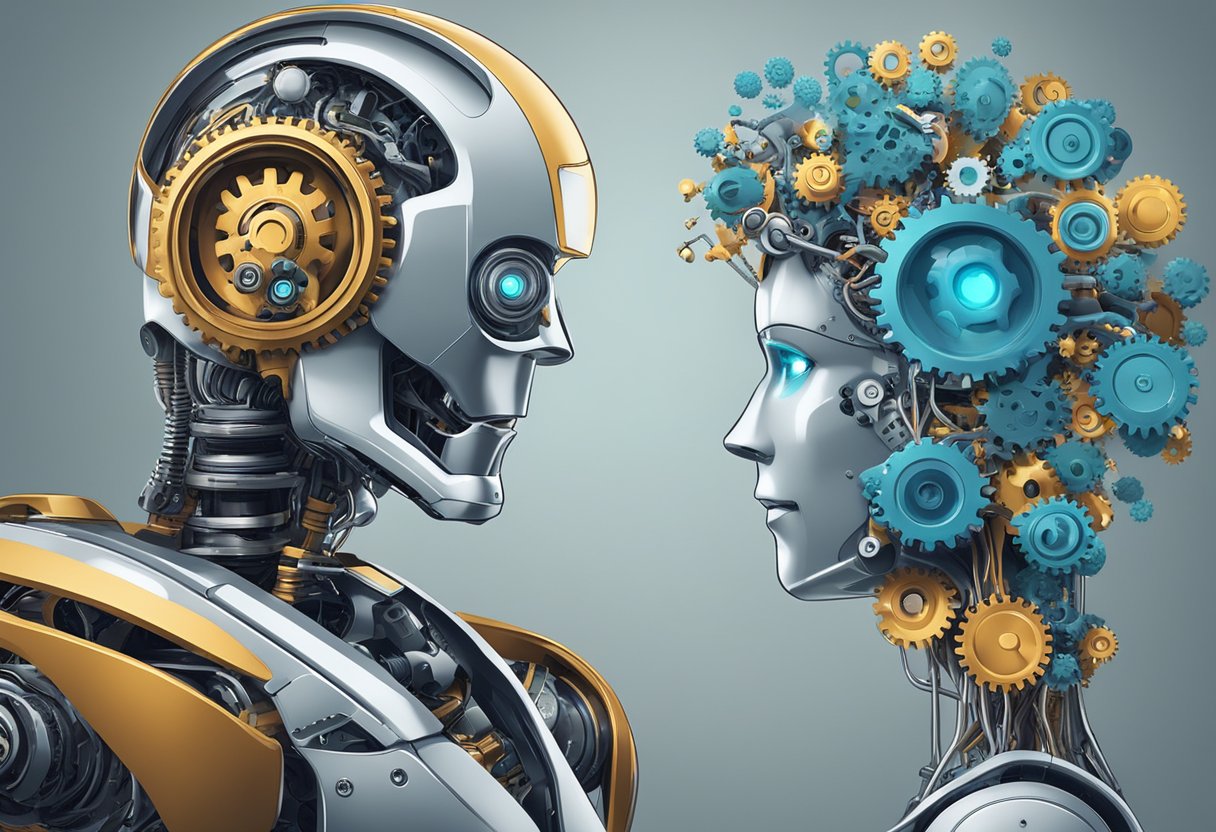Machine Learning vs Deep Learning: Understanding the Key Differences and Applications
Machine learning and deep learning are two powerful tools in the field of artificial intelligence. The key difference is that machine learning focuses on algorithms that improve with experience, while deep learning uses neural networks to analyze complex data patterns. Understanding these concepts helps clarify how businesses and technologies can leverage them for better decision-making.

In today’s tech landscape, these tools are not merely buzzwords; they are essential in driving innovation. From self-driving cars to virtual assistants, machine learning and deep learning play vital roles in shaping the future. As industries continue to evolve, grasping the differences and applications of these technologies becomes increasingly important for professionals and enthusiasts alike.
By exploring the strengths and challenges of machine learning and deep learning, readers can better appreciate how these technologies impact their daily lives and the systems they interact with. This knowledge opens up opportunities for informed discussions and decisions in an ever-advancing digital world.
Key Takeaways
- Machine learning improves through data-driven algorithms while deep learning utilizes neural networks.
- Both technologies have unique applications that significantly impact various industries.
- Understanding their differences can lead to better technology choices and solutions.
Conceptual Foundations
Machine learning and deep learning are two key areas in the field of artificial intelligence. Each has its own methods and goals, which are important to understand for anyone interested in technology.
Defining Machine Learning
Machine learning (ML) refers to a type of artificial intelligence that enables systems to learn from data. It uses algorithms to identify patterns and make decisions without explicit programming.
Key types of ML include:
- Supervised Learning: The model learns from labeled data.
- Unsupervised Learning: The model finds patterns in unlabeled data.
- Reinforcement Learning: The model learns through trial and error.
Machine learning often requires large datasets. The more data it has, the better it can generalize from examples. Applications range from image recognition to product recommendations.
Defining Deep Learning
Deep learning (DL) is a specialized area of machine learning that uses artificial neural networks. These networks consist of layers of interconnected nodes that mimic the way the human brain processes information.
Key features include:
- Hierarchical Learning: DL models can learn multiple levels of abstraction.
- Large Data Requirements: They generally need thousands of data points for effective performance.
- Complex Architectures: These can include convolutional neural networks for images and recurrent neural networks for sequences.
Deep learning shines in tasks like speech recognition and natural language processing, where traditional ML methods may struggle.
Key Distinctions
While both approaches belong to artificial intelligence, they differ significantly.
- Data Needs: Machine learning can work with smaller datasets, while deep learning demands large amounts of data.
- Complexity: Deep learning models are usually more complex, consisting of many layers, which enables them to capture intricate patterns.
- Computational Power: Deep learning requires more processing power due to its network architectures, often leveraging GPUs for efficiency.
By understanding these differences, one can better choose the appropriate method for a given task in AI development.
Underlying Technologies
Machine learning and deep learning both utilize complex layers and structures to process data. Key technologies within these fields include neural networks, recurrent neural networks, and convolutional neural networks. Each plays a crucial role in how these systems learn and make predictions.
Neural Networks and Layers
Neural networks form the basis of deep learning. An artificial neural network (ANN) consists of nodes, or neurons, connected in layers. There are typically three types of layers: input, hidden, and output.
- Input Layer: Accepts the initial data.
- Hidden Layers: Perform computations, transforming inputs into outputs.
- Output Layer: Delivers the final result.
A deep neural network (DNN) has multiple hidden layers. This depth allows DNNs to learn complex patterns and relationships in data. The effectiveness of a neural network depends on its architecture and the quality of the training data used.
Recurrent Neural Networks (RNNs)
Recurrent neural networks are special types of neural networks designed for sequential data. RNNs process inputs in a sequence, allowing them to remember previous inputs through hidden states.
This makes them particularly useful for tasks like:
- Natural Language Processing (NLP): RNNs can model sentences by retaining context.
- Time-Series Data: They can predict future values based on past information.
However, basic RNNs can struggle with long-term dependencies. Enhanced versions, like Long Short-Term Memory (LSTM) networks, help mitigate this issue by maintaining information over longer sequences.
Convolutional Neural Networks (CNNs)
Convolutional neural networks excel in image processing tasks. They consist of:
- Convolutional Layers: Apply filters to input images, detecting features like edges or textures.
- Pooling Layers: Reduce the size of feature maps, helping to focus on the most important information.
- Fully Connected Layers: Serve as the output layer, providing final predictions.
CNNs are highly effective in various applications such as image recognition, video analysis, and even medical imaging. Their architecture allows them to automatically learn and identify patterns, making them a powerful tool in deep learning.
Data Handling
Data handling is crucial in both machine learning and deep learning. They differ in how they manage and process various types of data. Understanding these differences helps in selecting the right approach for a specific task.
Structured vs. Unstructured Data
Structured data is organized and easily searchable. It typically comes in tables with rows and columns, such as spreadsheets or databases. Examples include numbers, dates, and categories. This data works well with traditional machine learning methods.
Unstructured data, on the other hand, lacks a clear format. It includes text, images, audio, and video. This type of data is more complex and harder to analyze. Deep learning excels in handling unstructured data. For instance, it can analyze large volumes of social media posts or medical images effectively. The ability to process unstructured data makes deep learning suitable for applications like natural language processing and computer vision.
Feature Extraction and Engineering
Feature extraction involves selecting relevant information from data to improve model performance. This is particularly important with unstructured data. Deep learning often automates this process, identifying patterns without extensive human input.
Feature engineering is the practice of creating new features from existing data. It enhances model accuracy and efficiency. For structured data, this could mean combining or transforming variables into more useful formats. For example, transforming timestamps into day or hour.
In deep learning, the model automatically learns which features to focus on, allowing it to work effectively with large datasets. This difference highlights the efficiency of deep learning in feature selection compared to traditional methods, which often rely on manual effort.
Learning Types
Machine learning uses various methods to teach models how to analyze and learn from data. The main types include supervised learning, unsupervised learning, and reinforcement learning. Each method has specific applications and learning strategies.
Supervised Learning
In supervised learning, models learn from labeled data. This means that each training example comes with a corresponding output label. Common tasks include classification and regression.
Examples:
- Predicting house prices based on features like size and location.
- Classifying emails as spam or not spam.
The model adjusts its parameters based on the errors it makes during training. It continues to learn until it performs well on not just the training data, but also unseen data. This method is widely used in industries such as finance and healthcare.
Unsupervised Learning
Unsupervised learning involves training models on data without labels. The goal is to find patterns or groupings within the data. This type of learning is beneficial for discovering hidden structures.
Key techniques:
- Clustering, which groups similar data points together (e.g., market segmentation).
- Dimensionality reduction, which simplifies data while preserving important information (e.g., Principal Component Analysis).
These models can uncover insights that might not be evident with labeled data, making them valuable for exploratory data analysis, customer segmentation, and anomaly detection.
Reinforcement Learning
Reinforcement learning focuses on teaching models to make decisions through trial and error. The model learns by receiving rewards or penalties based on its actions in a given environment.
Key components:
- Agent: The learner or decision-maker.
- Environment: The context in which the agent operates.
- Actions: The choices made by the agent.
For example, an agent might learn to play a video game by maximizing its score through repeated play. Reinforcement learning is often applied in robotics, gaming, and autonomous systems. It excels in complex scenarios where the optimal solution isn’t immediately clear, requiring strategies based on past experiences.
Applications
Machine learning and deep learning have a wide range of real-world applications. They are used in various sectors, such as communication, healthcare, transportation, and entertainment, making processes more efficient and accurate.
Speech and Language Processing
Speech recognition is a key area where machine learning and deep learning shine. This technology converts spoken words into text, enabling applications like virtual assistants and transcription services.
Natural Language Processing (NLP) helps machines understand and respond to human language. Examples include language translation tools and chatbots that use sentiment analysis to gauge user emotions.
Machine learning algorithms can identify patterns in speech data, improving accuracy over time. Deep learning models use neural networks to enhance these tasks, recognizing nuances in language and accents.
Image and Object Recognition
Image recognition is another important application. Machine learning algorithms can classify and locate objects in images. This is used in security systems, such as facial recognition technology, which identifies individuals in photos and videos.
Deep learning takes this a step further. It can perform object detection, recognizing multiple items in a single image. This technology is vital for autonomous vehicles, allowing them to detect pedestrians, other cars, and traffic signals.
Furthermore, deep learning improves accuracy in image classification tasks, which are essential in healthcare for diagnosing medical conditions from imaging data.
Autonomous Systems and Robotics
Autonomous systems rely heavily on machine learning and deep learning. Autonomous vehicles, for instance, utilize deep learning algorithms to process data from various sensors. This allows them to navigate safely and effectively.
Robotics applications also benefit. Robots can learn from their environments using machine learning, adapting to changes and improving their performance.
Deep learning enhances robotic vision, enabling robots to recognize and interact with objects. This technology is crucial in industries like manufacturing and logistics, where precision and efficiency are essential.
Recommendation Systems and Personalization
Recommendation systems use machine learning to suggest products, movies, or music based on user preferences. They analyze past behaviors and choices to make personalized recommendations.
Deep learning contributes significantly to this process. By analyzing large data sets, deep learning models can uncover hidden patterns and trends in user behavior.
These systems improve user experience in platforms like Netflix and Amazon. They provide tailored suggestions that keep users engaged, ultimately enhancing customer satisfaction and sales. By understanding user preferences on a deeper level, companies can improve their marketing strategies.
Technical Challenges
Machine learning and deep learning both face important technical challenges. These challenges impact their effectiveness and efficiency in real-world applications.
Scalability and Computational Resources
Scalability is a key challenge. Machine learning techniques can often work with smaller datasets, but as datasets grow, the need for computational resources increases significantly. Deep learning typically requires larger datasets and more powerful hardware.
This hardware dependency often results in high execution costs. For example, training deep learning models may require GPUs or TPUs to handle the parallel processing needed for large-scale data. Insufficient computational resources can lead to slower training times and less effective models. Effective scaling strategies include optimizing model architecture or using distributed computing systems.
Performance Optimization
Performance optimization is crucial for both machine learning and deep learning. This involves tuning algorithms to improve accuracy and reduce execution time. For machine learning, selecting the right algorithm and fine-tuning hyperparameters can greatly enhance performance.
In deep learning, optimizing neural networks can be complex. Techniques like dropout, batch normalization, and using various optimizers help improve model performance. Additionally, hardware-specific optimization can significantly enhance speed, allowing for faster execution and better resource utilization. Each of these aspects plays a significant role in ensuring that models perform effectively under varying conditions.
Model Characteristics
Model characteristics shape how machine learning and deep learning approaches analyze data. These characteristics determine how interpretable models are, the types of architectures used, and specific algorithms that define each approach.
Interpretability and Transparency
Interpretability refers to how easily a human can understand the decisions made by a model. Traditional machine learning models like Decision Trees and Support Vector Machines are known for their transparency. They often provide clearer insights into how they reach conclusions, which is beneficial in fields like healthcare and finance.
In contrast, deep learning models, especially those using Generative Adversarial Networks (GANs), can be more complex. Though they produce high-quality outputs, the inner workings are often harder to explain. This lack of transparency can pose challenges in critical applications where understanding the reasoning behind decisions is essential.
Generative Models
Generative models, particularly from deep learning, focus on creating data rather than just analyzing it. Generative Adversarial Networks (GANs) are a prime example. They consist of two neural networks, a generator and a discriminator, that work against each other to produce realistic data.
This technique has applications in art generation, image enhancement, and even video game design. With advancements, they can learn intricate patterns from large datasets, but their complexity can make interpretability a challenge. This duality of capability and complexity makes understanding the generated outputs crucial for users.
Decision Trees and Ensembles
Decision Trees are a foundational element of machine learning. They split data into branches based on feature values, making it easy to visualize and interpret predictions. When combined in an ensemble method like Random Forest, they enhance prediction accuracy by averaging multiple trees’ outputs.
Ensemble methods leverage the strengths of many models to improve performance and reduce overfitting. This method balances accuracy with interpretability, allowing users to get insights from their predictions. These characteristics are vital for applications needing both reliability and guidance to make informed decisions.
Impact on Industries
Machine learning and deep learning are transforming various industries by enhancing efficiency, accuracy, and decision-making. These technologies improve results in sectors like healthcare, finance, manufacturing, and cybersecurity.
Healthcare and Life Sciences
Machine learning is revolutionizing healthcare by analyzing large datasets for better patient outcomes. It helps in diagnosing diseases early through data patterns. For instance, algorithms can process medical images, identifying conditions like cancer more accurately than traditional methods.
Deep learning, specifically, excels in medical imaging. Convolutional neural networks (CNNs) are employed to detect anomalies in MRI or X-ray scans. By automating image analysis, doctors can focus on patient care rather than administrative tasks.
Additionally, machine learning aids in drug discovery by predicting how different compounds will react in the body. This accelerates research and development, making treatments available faster and at lower costs.
Finance and Fraud Detection
In finance, machine learning enhances security through improved fraud detection systems. Algorithms analyze transaction patterns to identify suspicious activities quickly. This real-time analysis is crucial in protecting customer accounts.
Deep learning adds another layer of security. Neural networks can recognize complex patterns in vast amounts of data, enabling it to adapt to new fraud techniques as they emerge. Institutions use these insights to adjust their strategies and mitigate risks.
Predictive models in finance also assess loan applications. By evaluating credit history data, machine learning systems can determine a candidate’s risk level, streamlining the approval process.
Manufacturing and Predictive Maintenance
Machine learning is integral to manufacturing, especially in predictive maintenance. Sensors on machinery collect data, which algorithms analyze to predict potential failures before they occur. This approach minimizes downtime and reduces repair costs.
Deep learning enhances quality control by using computer vision to detect defects in products during production. This not only improves product quality but also decreases waste by catching errors early.
Moreover, these technologies optimize supply chain logistics. By analyzing historical data, companies can forecast demand and manage inventory effectively, further enhancing operational efficiency.
Cybersecurity
Cybersecurity greatly benefits from machine learning and deep learning. These technologies identify patterns in user behavior and network traffic to spot anomalies that may indicate a security threat.
Machine learning algorithms can adapt to evolving cyber threats. They continuously learn from new data, improving their ability to detect attacks, such as phishing or malware infiltration. This proactive approach is essential for safeguarding sensitive information.
Deep learning enhances this further through intrusion detection systems. These systems analyze vast amounts of network data and can identify sophisticated attack patterns that might go unnoticed by traditional systems.
Future of Learning Technologies
Innovations in technology are transforming how learning happens. This section explores significant advancements in AI and the evolution of learning paradigms, highlighting key developments in machine learning and deep learning.
Advancements in AI
Artificial Intelligence continues to make impressive strides. Machine Learning (ML) and Deep Learning are central in creating smarter educational tools. These technologies can analyze vast amounts of data to provide personalized learning experiences.
Key advancements include:
- Transfer Learning: This allows models trained on one task to be adapted for another, increasing efficiency.
- Foundation Models: These large AI systems can be fine-tuned for various applications, such as language understanding or image recognition.
Hierarchical representations enable complex information to be processed effectively, enhancing the ability to teach through multiple layers of understanding. With these advancements, AI is set to revolutionize educational tools and resources.
Evolving Learning Paradigms
Learning paradigms are changing due to technological influence. Traditional methods are adapting to incorporate ML and AI, which enable different styles of learning.
Main features include:
- Adaptive Learning Systems: These dynamically adjust content based on individual performance, making education more personalized.
- Data-Driven Insights: Educators can use analytics to understand student progress and areas needing improvement.
Incorporating Machine Learning and Deep Learning into various fields helps tailor approaches to meet unique learner needs. These evolving paradigms signify a shift toward more interactive and engaging educational experiences.
Frequently Asked Questions

This section addresses common questions regarding the differences between machine learning and deep learning. The focus is on key aspects like data requirements, computational complexity, model accuracy, interpretability, feature engineering, and when to use deep learning.
What distinguishes machine learning from deep learning in terms of data requirements?
Machine learning typically requires less data to train models effectively. It can perform well with smaller datasets, relying more on manual feature selection. In contrast, deep learning generally needs large amounts of data to identify patterns and make predictions, as it automatically extracts features through multiple layers.
How do machine learning and deep learning differ in computational complexity?
Machine learning models tend to be simpler and less computationally intensive. They often use algorithms like decision trees or support vector machines. Deep learning models are more complex, requiring significant computational power and resources due to their deep network architectures, which can have many layers and parameters.
Can you explain the difference between the accuracy of models in machine learning versus deep learning?
Deep learning models usually achieve higher accuracy than traditional machine learning models in complex tasks. This is especially true for problems like image and speech recognition. However, machine learning models can perform better with smaller datasets or simpler problems, where deep learning might overfit.
What are the implications of model interpretability when comparing machine learning and deep learning?
Machine learning models are often more interpretable, as their inner workings can be easier to explain. Models like linear regression show clear relationships between inputs and outputs. Deep learning models, with their complex layers, often act as “black boxes,” making it hard to track how they arrive at specific decisions.
How does the approach to feature engineering differ between machine learning and deep learning?
Machine learning relies heavily on feature engineering, where practitioners manually select and create features that may be important for the model. In contrast, deep learning reduces the need for manual feature selection because neural networks automatically learn to extract features from raw data during the training process.
In what scenarios is deep learning preferred over traditional machine learning techniques?
Deep learning is preferred for tasks with large, complex datasets, such as image classification, natural language processing, and video analysis. It excels when high-dimensional data is involved, where traditional machine learning may struggle to find meaningful patterns without extensive feature engineering.






Post Comment